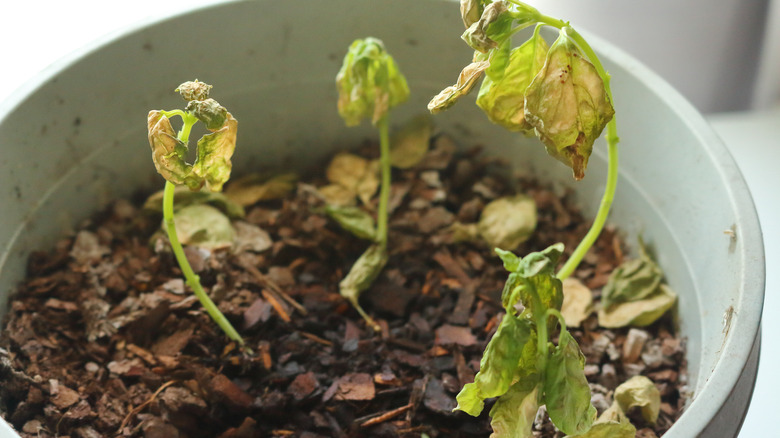There’s just something about homegrown basil, as it tastes delicious in countless meals and is fairly easy to grow. Whether you grow it outdoors or on your kitchen window sill, a basil plant will provide you with plenty of leaves to harvest. However, if you start to discover yellow leaves, you may become discouraged. Your first instinct may be to douse the plant in water to make it turn green again, but water isn’t the only factor that could make basil change colors, so you need to learn how to identify the cause. Basil can turn yellow for many reasons including issues with water, sunlight, fertilizer, and disease.
Fortunately, most of these problems can be corrected to save your plant and help it thrive. Fixing sunlight issues is easy, though water and fertilizer problems may be a bit more difficult, depending on the situation. Diseases can’t be cured, but you can remove the infected portions to prevent the entire plant from dying. Yellow leaves aren’t a sign that it’s too late — instead, they’re just a warning, and with some simple fixes, your basil could spring back to life.
Identify the problem

If you’re growing basil for the first time, you may have a few issues that lead to yellowing leaves. Basil should be watered deeply about once a week. If the soil becomes bone dry or saturated with water, leaves could turn yellow. Too much water can lead to more fungal diseases like root rot, which leads to yellow leaves and soggy roots. If yellow leaves appear on the bottom of the plant, it could mean you’re giving it too much fertilizer or not enough sun. Another common problem is basil downy mildew. The leaves will turn yellow between the veins and will have brown spores on the bottom portions. The yellow parts will turn brown as the disease progresses, eventually killing the entire plant.
Identifying the cause of yellow basil leaves may seem tricky, but you can use the context clues of how you’ve been caring for it to figure it out. Is it in a shady area? It could be a sunlight problem. Did you recently fertilize it? Perhaps it was too much. Understanding how plants communicate takes some practice, but it can be done.
Correct the problem
Once you’ve figured out why the leaves are yellow, you can work on correcting the problem to save the basil. Sunlight is a simple fix — move the basil where it will get more sunlight. This will be more difficult if it’s planted in the ground, but a potted plant won’t be an issue to move. Basil needs at least six hours of direct sunlight each day to be content.
Water and fertilizer issues can require a little more work to correct if you’re trying to undo too much of something. If your plants don’t have enough, give them more when watering or feeding them. If you gave your basil too much water, you may need to pour out any that’s puddling. In dire situations, you’ll need to repot the basil in a new pot or area with drier soil so it can have a chance to dry out. For over-fertilized plants, you can leach out the fertilizer by giving it a lot of water — at least 6 inches at once — so it will drain out the bottom of the container and wash out some of the fertilizer. In severe cases, you’ll need to repot the plants.
You can’t cure a diseased plant, but you can remove the infected parts and move it to a less humid area. Prevent disease from spreading again by treating the basil with fungicide or cinnamon. Avoid overwatering, as this can also lead to fungal diseases.